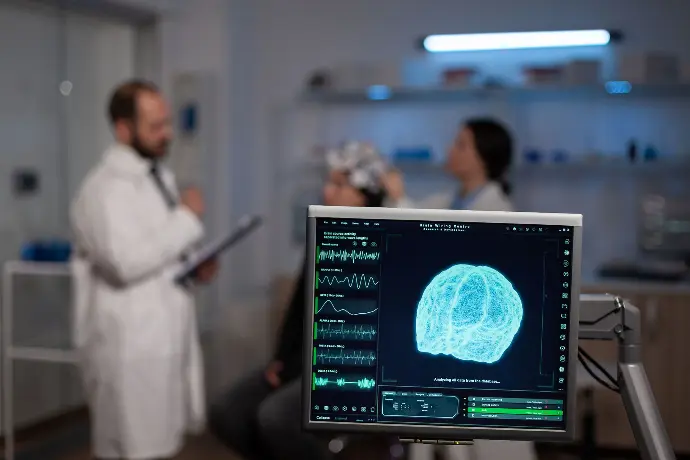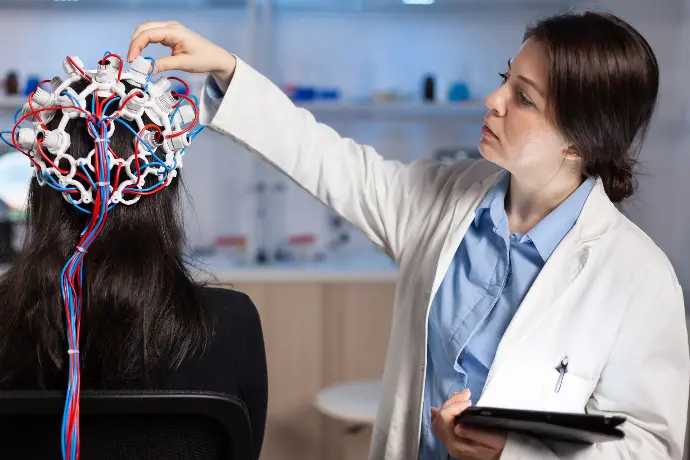Neurological disorders
Home > Neurological disorders

Dystonia

Parkinsonism

Spasticity

Ataxia

Preventative Neurology

Migraine

Peripheral neuropathy

Seizure and Epilepsy

Dystonia
Dystonia is a neurological movement disorder characterized by involuntary muscle contractions that cause repetitive or twisting movements and abnormal postures. These muscle contractions can result in sustained or intermittent movements, often causing twisting, repetitive movements, or abnormal postures.
Dystonia can affect one specific muscle, a group of muscles, or even the entire body. The severity and symptoms of dystonia can vary widely among individuals and may be triggered or worsened by certain activities, stress, or fatigue.
There are several types of dystonia, including:
a. Focal dystonia: affects one specific part of the body, such as the neck (cervical dystonia or spasmodic torticollis), hand (writer's cramp), or eyelids (blepharospasm).
b. Segmental dystonia: affects adjacent body regions, such as the neck and arm.
c. Generalized dystonia: affects multiple body regions or the entire body.
d. Task-specific dystonia: occurs during specific activities, such as playing a musical instrument or writing.
e. Dystonia-plus syndromes: involve dystonia along with other neurological symptoms.
The exact cause of dystonia is often unknown, but it is believed to involve a combination of genetic, environmental, and neurological factors. Treatment for dystonia may include medications, botulinum toxin injections (Botox, Dysport, Xeomin), physical therapy, and in some cases, surgery or deep brain stimulation DBS.
Dystonia can have a significant impact on daily life, but with proper management and support, many individuals with dystonia can lead fulfilling lives.

Parkinsonism
( Parkinson’s Disease vs Atypical Parkinsonian syndromes)
Dystonia is a neurological movement disorder characterized by involuntary muscle contractions that cause repetitive or twisting movements and abnormal postures. These muscle contractions can result in sustained or intermittent movements, often causing twisting, repetitive movements, or abnormal postures.
Dystonia can affect one specific muscle, a group of muscles, or even the entire body. The severity and symptoms of dystonia can vary widely among individuals and may be triggered or worsened by certain activities, stress, or fatigue.
The main types of atypical parkinsonian syndromes include:
- Multiple System Atrophy (MSA): MSA is characterized by a combination of parkinsonian symptoms along with autonomic dysfunction, such as orthostatic hypotension, urinary incontinence, and sexual dysfunction. It also involves symptoms related to impaired coordination and balance.
- Progressive Supranuclear Palsy (PSP): PSP is characterized by difficulties with balance, eye movement abnormalities (including vertical gaze palsy), cognitive impairment, and behavioral changes. It tends to progress more rapidly than Parkinson's disease.
- Corticobasal Syndrome (CBS): CBS is characterized by asymmetric rigidity and apraxia (difficulty with purposeful movements) in addition to other parkinsonian symptoms. It can also involve cognitive impairment and cortical sensory deficits.
- Dementia with Lewy Bodies (DLB): DLB is characterized by cognitive impairment, visual hallucinations, and fluctuating levels of alertness in addition to parkinsonian symptoms. It shares similarities with both Parkinson's disease and dementia.
These atypical parkinsonian syndromes can be challenging to diagnose and manage due to their diverse and often overlapping symptoms. Treatment strategies may involve symptom management with medications, physical therapy, speech therapy, and occupational therapy, but the response to treatment varies among individuals and may be less effective compared to Parkinson's disease. Early and accurate diagnosis by a neurologist experienced in movement disorders is crucial for appropriate management and support.

Spasticity
Spasticity is a condition characterized by stiffness and tightness of muscles, often leading to involuntary muscle contractions or spasms. It results from damage or dysfunction in the areas of the brain or spinal cord that control voluntary movement.
The most common causes of spasticity include:
a. Stroke: Spasticity is a common complication of stroke, which occurs when blood flow to a part of the brain is interrupted, leading to brain damage.
b. Multiple Sclerosis (MS): MS is a chronic autoimmune disease that affects the central nervous system (brain and spinal cord), leading to inflammation, demyelination (damage to the protective covering of nerve fibers), and impaired nerve function. Spasticity is a common symptom of MS.
c. Traumatic Brain Injury (TBI): Spasticity can occur as a result of damage to the brain caused by a traumatic injury, such as a blow to the head or a penetrating head injury.
d. Spinal Cord Injury (SCI): Damage to the spinal cord, often resulting from trauma or disease, can lead to spasticity. The level and severity of the spinal cord injury can affect the extent of spasticity.
e. Cerebral Palsy (CP): CP is a group of neurological disorders that affect movement, muscle tone, and coordination, often resulting from brain damage that occurs before, during, or shortly after birth. Spasticity is a common feature of CP, particularly spastic diplegia and spastic quadriplegia.
f. Brain Tumors: Tumors in the brain or spinal cord can disrupt the normal function of the nervous system, leading to spasticity as one of the symptoms.
g. Neurodegenerative Diseases: Certain neurodegenerative diseases, such as amyotrophic lateral sclerosis (ALS) and hereditary spastic paraplegia (HSP), can cause spasticity as they progress.
Spasticity can vary in severity from mild muscle stiffness to severe muscle spasms that interfere with daily activities. Management of spasticity typically involves a combination of treatments, including physical therapy, occupational therapy, medications (such as muscle relaxants or anti-spasticity medications), and in some cases, surgical interventions or intrathecal baclofen therapy. Treatment plans are often tailored to the individual needs and goals of the patient.

Ataxia
Ataxia is a neurological condition characterized by a lack of coordination of muscle movements, resulting in unsteady gait, difficulty with balance, and clumsiness. It occurs when there is damage to the part of the brain that controls voluntary movements and coordination, particularly the cerebellum or its connections.
The symptoms of ataxia can vary in severity and may include:
1. Unsteady gait: Individuals with ataxia often have difficulty walking in a coordinated manner, leading to a staggering or lurching gait.
2. Poor coordination: Activities that require precise movements, such as writing, buttoning a shirt, or using utensils, may be challenging for individuals with ataxia due to impaired coordination.
3. Slurred speech: Ataxia can affect the muscles involved in speech production, resulting in slurred or irregular speech patterns.
4. Tremors: Some individuals with ataxia may experience tremors, particularly during movements or when attempting to maintain a steady posture.
5. Difficulty with fine motor skills: Tasks that require fine motor skills, such as picking up small objects or tying shoelaces, may be challenging for individuals with ataxia.
Ataxia can be caused by various underlying conditions, including:
1. Genetic disorders: Some forms of ataxia are inherited and result from genetic mutations that affect the structure or function of the cerebellum or its connections. Examples include Friedreich's ataxia and spinocerebellar ataxias.
2. Acquired conditions: Ataxia can also occur as a result of acquired conditions, such as stroke, traumatic brain injury, brain tumors, multiple sclerosis, or alcohol abuse.
3. Degenerative diseases: Certain neurodegenerative diseases, such as multiple system atrophy (MSA) or cerebellar degeneration, can lead to progressive ataxia.
4. Autoimmune disorders: In some cases, the body's immune system may mistakenly attack the cerebellum, leading to autoimmune-related ataxia.
Treatment for ataxia depends on the underlying cause and may include physical therapy to improve balance and coordination, speech therapy to address communication difficulties, assistive devices to aid mobility, and medications to manage symptoms such as tremors or muscle stiffness. In some cases, treating the underlying condition or genetic counseling may also be beneficial.

Preventative Neurology
Preventive neurology focuses on strategies and interventions aimed at reducing the risk of neurological disorders, minimizing disease progression, and promoting brain health throughout life. It encompasses various approaches, including lifestyle modifications, early detection and management of risk factors, and the development of targeted interventions based on individual risk profiles. Here are some key aspects of preventive neurology:
1. Healthy Lifestyle Promotion: Encouraging individuals to adopt healthy lifestyle habits can have a significant impact on brain health. This includes promoting regular exercise, a balanced diet rich in fruits, vegetables, and whole grains, maintaining a healthy weight, managing stress, getting adequate sleep, and avoiding harmful substances such as tobacco and excessive alcohol.
2. Cardiovascular Risk Management: Many neurological conditions, such as stroke, vascular dementia, and cognitive decline, share common risk factors with cardiovascular disease. Preventive neurology emphasizes the importance of managing cardiovascular risk factors, including hypertension, diabetes, high cholesterol, and obesity, to reduce the risk of cerebrovascular events and neurodegenerative disorders.
3. Cognitive Stimulation: Engaging in mentally stimulating activities, such as reading, puzzles, learning new skills, and social interactions, can help preserve cognitive function and reduce the risk of cognitive decline and dementia.
4. Early Detection and Treatment: Regular health screenings and assessments can help identify early signs of neurological disorders or risk factors, allowing for early intervention and treatment. This may include screenings for conditions such as Alzheimer's disease, Parkinson's disease, multiple sclerosis, and epilepsy.
5. Genetic Counseling and Testing: For individuals with a family history of neurological disorders or genetic predisposition, genetic counseling and testing can provide valuable information about their risk and help guide personalized preventive strategies.
6. Environmental and Occupational Health: Identifying and minimizing exposure to environmental toxins, pollutants, and occupational hazards that may contribute to neurological disorders is an important aspect of preventive neurology.
7. Research and Innovation: Continued research into the underlying mechanisms of neurological diseases, risk factors, and preventive interventions is essential for advancing the field of preventive neurology. This includes the development of new diagnostic tools, treatment modalities, and preventive strategies.
By adopting a proactive approach to brain health and implementing targeted preventive measures, individuals can reduce their risk of neurological disorders and optimize their overall well-being and quality of life across the lifespan.
If you would like to get more information about our preventative Neurology clinic please contact us. This service is Medicare non-rebatable clinic

Migraine
Migraine is a neurological disorder characterized by recurrent episodes of severe headache, often accompanied by other symptoms such as nausea, vomiting, sensitivity to light and sound, and visual disturbances (aura). Migraine headaches can be debilitating and significantly impact daily functioning, leading to decreased productivity and quality of life for affected individuals.
The exact
cause of migraine is not fully understood, but it is believed to involve a
combination of genetic, environmental, and neurological factors. Triggers for
migraine attacks can vary widely among individuals and may include certain
foods or beverages, hormonal changes, stress, sleep disturbances, sensory
stimuli (such as strong smells or bright lights), weather changes, and certain
medications.
Treatment for migraine typically involves a combination of acute treatment to relieve symptoms during an attack and preventive treatment to reduce the frequency and severity of migraine episodes. Acute treatments may include over-the-counter or prescription medications such as nonsteroidal anti-inflammatory drugs (NSAIDs), triptans, anti-nausea medications, or combination medications specifically designed for migraine relief.
In addition to traditional acute and preventive treatments, several advanced treatments and therapies are available for migraine management, including:
1. Botulinum Toxin Injections (Botox): Botox injections have been approved by the FDA for the preventive treatment of chronic migraine in adults. Botox is injected into specific muscles of the head and neck every 12 weeks, and it works by blocking the release of chemicals involved in migraine pain.
2. CGRP Monoclonal Antibodies: Calcitonin gene-related peptide (CGRP) monoclonal antibodies are a relatively new class of preventive medications specifically designed for migraine. These drugs, including Fremanezumab, and Galcanezumab, target CGRP or its receptor to reduce the frequency and severity of migraine attacks.
3. Transcranial Magnetic Stimulation (TMS): TMS is a non-invasive neuromodulation technique that involves applying magnetic pulses to specific areas of the brain. It has been shown to be effective in both acute and preventive treatment of migraine, and devices such as the SpringTMS and eNeura sTMS have been approved for use in migraine management in some countries.
4. Occipital Nerve Stimulation (ONS):ONS involves the implantation of electrodes near the occipital nerves at the base of the skull. By delivering electrical impulses to these nerves, ONS can modulate pain signals and provide relief for chronic migraine sufferers who have not responded to other treatments.
5. Sphenopalatine Ganglion (SPG) Block: SPG block is a minimally invasive procedure that involves administering local anesthetic to the SPG, a cluster of nerves located behind the nose. SPG blocks can provide acute relief for migraine attacks and may also be used as a preventive treatment in some cases.
These advanced treatments offer additional options for migraine management, particularly for individuals who have not responded adequately to conventional therapies or who experience frequent or severe migraine attacks. However, it's important for individuals with migraine to work closely with their healthcare providers to develop a personalized treatment plan that addresses their specific needs and preferences.

Peripheral Neuropathy
Peripheral neuropathy is a condition characterized by damage to the peripheral nerves, which are the nerves outside the brain and spinal cord. These nerves are responsible for transmitting signals between the central nervous system (brain and spinal cord) and the rest of the body, including muscles, skin, and internal organs.
Peripheral neuropathy can cause a wide range of symptoms, depending on which nerves are affected and the extent of the damage. Common symptoms include:
1. Numbness or tingling in the hands, feet, arms, or legs
2. Weakness or loss of muscle control
3. Sharp, stabbing, or burning pain
4. Sensitivity to touch or temperature changes
5. Muscle cramps or spasms
6. Difficulty with coordination and balance
7. Changes in sensation or coordination that may affect walking or fine motor skills
Peripheral neuropathy can have many different causes, including:
1. Diabetes: Diabetic neuropathy is one of the most common causes of peripheral neuropathy and is associated with long-term uncontrolled diabetes.
2. Metabolic, Hormonal and Nutritional : such as Thyroid disease , Vitamin B12 , Folate and Thiamine deficiencies can potentially cause peripheral Neuropathy
3. Infections: Certain infections, such as HIV/AIDS, hepatitis C, and shingles (herpes zoster), can lead to peripheral neuropathy.
4. Autoimmune diseases: Conditions like rheumatoid arthritis, lupus,Celiac disease, Guillain-Barré syndrome and CIDP can cause inflammation of the peripheral nerves.
5. Exposure to toxins and medications: Certain chemicals, medications (such as chemotherapy drugs), and excessive alcohol use can damage peripheral nerves.
6. Hereditary factors: Some forms of peripheral neuropathy are inherited and can run in families.
7. Idiopathic , when the cause cannot be determined. (20-30 % of all cases)
Treatment for peripheral neuropathy focuses on managing symptoms and addressing the underlying cause when possible. This may include medications to relieve pain or reduce inflammation, physical therapy to improve muscle strength and coordination, lifestyle modifications (such as managing blood sugar levels in diabetes ), and avoiding exposure to toxins or other aggravating factors such as Alcohol. In some cases, treatments such as nerve blocks, transcutaneous electrical nerve stimulation (TENS), or alternative therapies like acupuncture may also be recommended.

Seizure and Epilepsy
A seizure is a sudden, uncontrolled electrical disturbance in the brain that can cause changes in behavior, movements, feelings, or levels of consciousness. Seizures can vary widely in their presentation and severity, ranging from mild episodes with subtle symptoms to severe convulsions and loss of consciousness.
Epilepsy, on the other hand, is a chronic neurological disorder characterized by recurrent seizures. It's important to note that not all seizures are indicative of epilepsy. Epilepsy is diagnosed when a person has had two or more unprovoked seizures, meaning the seizures were not triggered by a specific event or acute medical condition.
There are many different types of seizures, and they can be classified into two main categories:
1. Focal seizures (formerly called partial seizures): These seizures originate in a specific area of the brain and may affect only one part of the body or cause specific symptoms depending on the area of the brain involved.
2. Generalized seizures: These seizures involve widespread electrical discharges throughout the brain and typically affect both sides of the body. Generalized seizures can cause loss of consciousness and may include subtypes such as tonic-clonic seizures (formerly known as grand mal seizures), absence seizures (formerly known as petit mal seizures), and myoclonic seizures, among others.
The causes of seizures and epilepsy can vary and may include genetic factors, brain injury, infections, brain tumors, developmental disorders, stroke, or other medical conditions. Treatment for epilepsy typically involves antiepileptic medications to control seizures. In some cases, surgery, dietary therapy (such as the ketogenic diet), or neuromodulation techniques may be considered for those who do not respond well to medication. Management of epilepsy often requires a multidisciplinary approach involving neurologists, epileptologists, and other healthcare professionals.